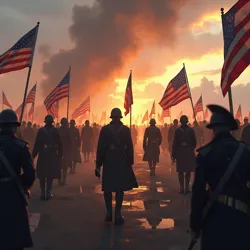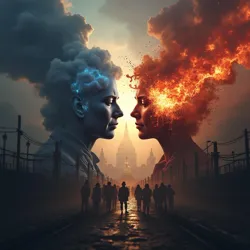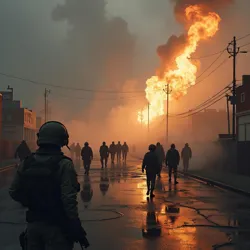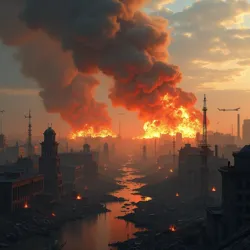The Great Discord: The American Civil War (2030-2038)

Second American Civil War in North America, 2030-2038, from political and social divides.
The Great Discord
Second American Civil War
2030
2038
North America
ten million
The Great Discord, also known as the Second American Civil War, was a protracted and devastating conflict fought on the North American continent primarily within the borders of the former United States of America from 2030 to 2038. The war originated from deep political and social divisions that intensified following the contentious 2028 presidential election and subsequent inauguration in early 2029. Initially framed as a struggle between factions aligned with the Democratic and Republican parties, the conflict rapidly devolved into a multi-sided civil war, drawing in disparate militant groups, regionalist movements, and eventually, foreign powers. Marked by extreme brutality, widespread war crimes, and the use of weapons of mass destruction, the Great Discord resulted in an estimated ten million fatalities and fundamentally reshaped the political and social landscape of North America. Unlike the American Civil War of the 19th century, which was largely a conflict between two geographically distinct entities, the Great Discord was a more fragmented and ideologically complex struggle for control of the former United States government, bearing similarities to 20th and 21st century civil conflicts such as the Russian Civil War, the Spanish Civil War, the Syrian Civil War, and the Chinese Civil War.
Origins of the Conflict
The seeds of the Great Discord were sown in the increasingly polarized political climate of the 2020s. Deepening societal divisions along ideological, geographical, and demographic lines, exacerbated by economic anxieties, social media echo chambers, and a decline in public trust in institutions, created a volatile environment. The 2028 United States presidential election proved to be the catalyst that ignited these simmering tensions into open conflict.
 Political polarization and 2028 election crisis created conditions for the Great Discord.
Political polarization and 2028 election crisis created conditions for the Great Discord.2028 Election and the Inauguration Crisis
The 2028 election was characterized by historically low voter turnout and widespread accusations of voter suppression and electoral fraud from both major parties. The results were extremely close, with neither the Democratic nor Republican candidate securing a clear mandate. Disputes over vote counts in several key swing states led to prolonged legal battles and recounts, further inflaming partisan passions. The Electoral College outcome was contested, and competing slates of electors were submitted from multiple states, creating a constitutional crisis in the lead-up to the 2029 presidential inauguration.
As January 2029 approached, the political situation deteriorated rapidly. Mass protests erupted in cities across the nation, often turning violent as clashes between opposing groups became commonplace. Far-right militias and paramilitary organizations, emboldened by rhetoric of election theft and government overreach, began mobilizing openly. Simultaneously, far-left groups, decrying systemic inequality and perceived threats to democratic norms, organized counter-protests and prepared for potential civil unrest.
The inauguration day itself was marked by chaos and violence in Washington D.C. Security forces struggled to maintain order as rival demonstrations converged on the capital. Amidst the turmoil, the Republican candidate was sworn in as president in a heavily fortified ceremony. However, the legitimacy of the inauguration was immediately challenged by the Democratic party and a significant portion of the population. Within days, several state governors, primarily in states with Democratic majorities, declared that they no longer recognized the authority of the federal government and announced their intention to secede from the Union, triggering the formal onset of the Great Discord.
The "Years of Lead" (2030-2031)
The initial phase of the conflict, often referred to as the "Years of Lead," was characterized by a period of escalating low-intensity violence and political maneuvering. Following the declarations of secession, a patchwork of states and territories aligned themselves with either the Federalist States of America (FSA), largely comprising the states that had seceded and their allies, or the United States Provisional Government (USPG), representing the rump federal government and the states that remained loyal.
The FSA, headquartered initially in Atlanta, Georgia, and later in Birmingham, Alabama, presented itself as the true successor to the American republic, arguing that the USPG had become illegitimate due to electoral malfeasance and ideological extremism. The USPG, based in a heavily fortified Denver, Colorado, maintained that it was the legitimate continuation of the federal government and that the FSA was engaged in an illegal rebellion.
During the "Years of Lead," direct military confrontations between the FSA and USPG were relatively limited and localized. Instead, the conflict manifested primarily as:
- Localized Armed Clashes: Sporadic skirmishes between FSA and USPG aligned militias and National Guard units occurred in border regions and contested territories. These clashes, often involving improvised explosive devices (IEDs), small arms fire, and occasional ambushes, resulted in a steady trickle of casualties and heightened tensions.
- Paramilitary Violence: Far-right and far-left extremist groups engaged in targeted assassinations, bombings, and acts of sabotage against political opponents and infrastructure targets. Groups such as the Crimson Brigades, a loose network of white supremacist and neo-fascist organizations allied with the FSA, and the People's Reclamation Front, a radical leftist group sympathetic to the USPG, became increasingly active.
- Economic Warfare: Both the FSA and USPG implemented economic blockades and trade restrictions against each other, disrupting supply chains and exacerbating economic hardship across the country. Control of key infrastructure, such as ports, railroads, and waterways, became a major point of contention.
- Propaganda and Information Warfare: Both sides engaged in intense propaganda campaigns aimed at shaping public opinion and demonizing the enemy. Social media platforms became battlegrounds for disinformation and psychological operations, further polarizing the population.
This period of simmering conflict created an atmosphere of fear and uncertainty. Millions of civilians were displaced from their homes due to violence and economic disruption. The authority of both the FSA and USPG remained tenuous outside of their core territories, and the risk of a full-scale civil war loomed large.
Escalation and Factionalization (2032-2034)
The "Years of Lead" ended abruptly in early 2032 with a series of events that dramatically escalated the conflict into a full-scale civil war. The catalyst was the Oklahoma City Incident, a devastating attack on the USPG capital by FSA-aligned militants.
 Oklahoma City Incident caused full-scale war and emergence of PCR, RoT, LFN.
Oklahoma City Incident caused full-scale war and emergence of PCR, RoT, LFN.The Oklahoma City Incident and the Outbreak of Full-Scale War
In February 2032, a coordinated attack involving multiple car bombs and a ground assault targeted key government buildings and military installations in Denver. While the USPG claimed the attack involved the use of chemical weapons (specifically, chlorine gas), this was never independently verified, though the scale of civilian casualties was undeniable. The Oklahoma City Incident resulted in thousands of deaths and widespread panic, galvanizing both sides for open warfare.
The USPG government, under President Eleanor Vance, declared a state of national emergency and vowed to crush the FSA rebellion. A nationwide mobilization order was issued, and the USPG launched a major military offensive into FSA-held territory. The FSA, under President Caleb Thornton, responded in kind, declaring a "War of National Liberation" and calling upon its supporters to rise up against the "tyrannical regime" in Denver.
The initial months of the full-scale war saw rapid advances and retreats on both sides. The USPG, possessing a larger standing army and greater industrial capacity, initially gained ground in the Midwest and along the East Coast. However, the FSA, benefiting from strong popular support in the South and parts of the West, and employing effective guerilla warfare tactics, managed to stall the USPG advance and inflict significant casualties.
Emergence of Third Factions and Regional Conflicts
As the war intensified, it became increasingly clear that the conflict was not simply a two-sided affair between the FSA and USPG. Pre-existing regional tensions and the rise of new militant groups led to the fragmentation of the conflict into a multi-sided civil war. Key third factions that emerged included:
- The Pacific Cooperative Republic (PCR): Formed in 2033, the PCR comprised the states of California, Oregon, and Washington, along with parts of Nevada and Idaho. The PCR declared its neutrality in the FSA-USPG conflict and focused on consolidating its own territorial control and establishing an independent socialist republic. Drawing on strong anti-war sentiment and a tradition of progressive politics in the Pacific Northwest, the PCR managed to maintain a precarious independence throughout much of the war, though it was constantly threatened by both the FSA and USPG, as well as internal divisions between moderate socialists and more radical elements. The PCR was led by the charismatic former Governor of California, Javier Ramirez.
- The Republic of Texas (RoT): Taking advantage of the chaos, Texas declared its independence for a second time in 2032. Unlike the PCR, the RoT was explicitly aligned with the FSA ideologically, but sought to maintain a degree of autonomy and control over its own resources, particularly its oil and natural gas reserves. The RoT, under President Abigail Walker, quickly established a strong military and played a significant role in the western theater of the war, often cooperating with FSA forces but pursuing its own strategic objectives.
- The Lakota Free Nation (LFN): Indigenous groups, particularly the Lakota people of the Great Plains, seized the opportunity to assert their sovereignty and reclaim ancestral lands. The LFN, under the leadership of Chief Tatanka Oyate, declared independence in 2033 and engaged in armed conflict with both the FSA and USPG, as well as neighboring state militias. The LFN's struggle gained international attention and sympathy, but its limited resources and geographical isolation made its position highly vulnerable.
These third factions, along with numerous smaller regionalist and separatist movements, further complicated the conflict and transformed it from a primarily ideological struggle into a complex web of overlapping wars. Areas such as the Appalachian Mountains, the Great Lakes region, and the Southwest became particularly fragmented, with shifting front lines and a constant struggle for control between multiple armed groups.
Foreign Intervention
The Great Discord attracted the attention of numerous foreign powers, each with their own strategic interests and ideological agendas. While no nation formally intervened with large-scale ground forces, several countries provided covert and overt support to various factions, further fueling the conflict and prolonging its duration. Key foreign interventions included:
- Russia: The Russian Federation, under President Dmitri Volkov, saw the Great Discord as an opportunity to weaken its long-time geopolitical rival, the United States. Russia provided clandestine support to the FSA, including financial aid, weapons, and intelligence, hoping to exacerbate internal divisions and undermine American power. Russian propaganda outlets also actively promoted pro-FSA narratives and fueled anti-USPG sentiment globally.
- China: The People's Republic of China, under General Secretary Xi Jinping, initially adopted a cautious approach, but gradually began to favor the USPG. While wary of directly antagonizing the FSA's allies, China recognized the USPG as the more stable and internationally recognized entity. China provided limited economic assistance and humanitarian aid to the USPG, and engaged in diplomatic efforts to promote a negotiated settlement to the conflict, primarily to ensure stability for international trade.
- European Union (EU): The European Union, particularly Germany and France, struggled to formulate a unified response to the Great Discord. Public opinion within the EU was divided, with some sympathizing with the FSA's claims of self-determination and others supporting the USPG's efforts to maintain national unity. The EU officially adopted a neutral stance, but individual member states provided varying degrees of humanitarian aid to civilian populations affected by the war. The EU was particularly concerned about the humanitarian crisis and the potential for refugee flows into Europe.
- Mexico: Mexico, under President Sofia Alvarez, faced a complex dilemma. The Great Discord created both opportunities and risks for Mexico. The weakening of the United States presented an opportunity for Mexico to assert greater regional influence, but the instability and violence spilling across the border posed a serious threat. Mexico officially remained neutral but unofficially leaned towards the USPG, fearing the potential for right-wing extremism and instability spreading from the FSA. Mexico also provided humanitarian assistance to refugees fleeing the conflict and strengthened its border security to manage migration flows.
Foreign intervention further complicated the already fractured landscape of the Great Discord, turning it into a proxy conflict between rival global powers and exacerbating the brutality and duration of the war.
The Brutal Years (2035-2037)
The period from 2035 to 2037 marked the most brutal and destructive phase of the Great Discord. Military operations intensified, war crimes became rampant, and weapons of mass destruction were deployed, pushing the conflict to the brink of total societal collapse.
 Use of WMDs and war crimes marked the most destructive years of the Great Discord.
Use of WMDs and war crimes marked the most destructive years of the Great Discord.The Use of Weapons of Mass Destruction
The most horrifying turning point in the Great Discord was the deployment of weapons of mass destruction. In late 2035, the FSA, facing mounting military setbacks and fearing imminent defeat, resorted to the use of tactical nuclear weapons. The first nuclear strike targeted a major USPG military logistics hub near Kansas City, Missouri. The detonation, while relatively small in yield, caused massive destruction and casualties, and sent shockwaves across the globe.
The USPG retaliated swiftly, launching its own nuclear strikes against FSA military targets and strategic infrastructure. While both sides claimed to be targeting only military objectives, civilian casualties were immense. Major cities, including Atlanta, Birmingham, Dallas, and Oklahoma City, suffered devastating nuclear attacks. The use of nuclear weapons led to widespread radioactive contamination, long-term health consequences, and a dramatic escalation of global tensions.
In addition to nuclear weapons, chemical and biological weapons were also deployed during this period. Both the FSA and USPG accused each other of using nerve agents and biological toxins in battlefield situations and against civilian populations. While the extent of chemical and biological weapons use remains debated, credible reports and investigations documented numerous instances of attacks using mustard gas, sarin gas, and weaponized anthrax. These attacks caused horrific suffering and further eroded any remaining moral constraints in the conflict.
War Crimes and Atrocities
The Great Discord was characterized by systematic and widespread war crimes committed by all factions. As the conflict descended into total war, respect for the laws of war and basic human rights completely collapsed. Documented war crimes included:
- Massacres of Civilians: Numerous massacres of civilians were perpetrated by all sides, often targeting ethnic, religious, or political minorities. The Chicago Cleansing in 2036, in which FSA-aligned militias systematically murdered thousands of African American and Hispanic residents of Chicago, became a symbol of the war's brutality. Similarly, the Denver Purges in 2037, conducted by USPG security forces against suspected FSA sympathizers, resulted in the extrajudicial killings of thousands of civilians.
- Torture and Summary Executions: Torture and summary executions of prisoners of war and suspected enemy combatants were commonplace. Both the FSA and USPG operated clandestine detention facilities where prisoners were subjected to horrific abuses. The PCR and RoT, while claiming to adhere to higher standards, were also implicated in instances of torture and extrajudicial killings.
- Rape and Sexual Violence: Rape and sexual violence were used as weapons of war by all factions. Systematic sexual violence against women and girls, and to a lesser extent men and boys, was documented in numerous reports. The breakdown of social order and the proliferation of armed groups created an environment of impunity in which sexual violence became rampant.
- Use of Child Soldiers: All factions, particularly the FSA and various paramilitary groups, recruited and deployed child soldiers. Desperate for manpower and exploiting the vulnerability of orphaned and displaced children, armed groups indoctrinated and forced children into combat roles, further compounding the tragedy of the conflict.
- Deliberate Targeting of Civilian Infrastructure: Both the FSA and USPG deliberately targeted civilian infrastructure, including hospitals, schools, power plants, and water treatment facilities. These attacks aimed to demoralize the enemy population and disrupt essential services, causing immense suffering and contributing to a humanitarian catastrophe.
The scale and scope of war crimes committed during the Great Discord were unprecedented in modern American history. International human rights organizations and war crimes tribunals struggled to document and prosecute these atrocities amidst the ongoing chaos and political fragmentation.
The Road to Peace (2037-2038)
By late 2037, the Great Discord had reached a point of mutual exhaustion and diminishing returns. Years of relentless warfare had devastated the country, shattered its economy, and decimated its population. The initial ideological fervor that had fueled the conflict had largely dissipated, replaced by war-weariness, despair, and a growing realization that no side could achieve a decisive military victory.
Shifting Tides and War Weariness
Several factors contributed to the shift towards peace negotiations in late 2037:
- Military Stalemate: After years of intense fighting, the front lines between the FSA and USPG had largely stabilized. Neither side possessed the military strength or resources to launch a decisive offensive. The war had devolved into a bloody stalemate of attrition, with both sides suffering unsustainable losses.
- Economic Collapse: The American economy, once the largest in the world, had completely collapsed under the strain of the war. Industrial production had plummeted, trade networks had disintegrated, and hyperinflation had rendered currency virtually worthless. Food shortages, fuel scarcity, and widespread unemployment exacerbated the suffering of the civilian population and undermined the war effort of all factions.
- Humanitarian Catastrophe: The humanitarian situation had reached catastrophic levels. Millions of people were displaced, starving, and suffering from disease. The healthcare system had collapsed, and basic sanitation was non-existent in many areas. The sheer scale of human suffering eroded public support for the war and increased pressure on political leaders to find a peaceful resolution.
- International Pressure: The international community, increasingly alarmed by the humanitarian crisis and the risk of further escalation, intensified diplomatic pressure on all factions to negotiate a ceasefire and peace settlement. The United Nations and various regional organizations offered mediation services and threatened sanctions against parties that refused to engage in peace talks.
The Indianapolis Accords and the End of the Great Discord
In early 2038, representatives from the USPG, FSA, PCR, and RoT, under intense international pressure and facing internal pressure from their own war-weary populations, agreed to participate in peace negotiations in Indianapolis, Indiana. The negotiations, mediated by a coalition of international diplomats and representatives from neutral nations, were protracted and fraught with difficulties. Deep-seated mistrust, unresolved grievances, and competing territorial claims threatened to derail the process on numerous occasions.
However, the overwhelming desire for peace, coupled with the dire consequences of continued conflict, ultimately prevailed. After months of intense negotiations, the Indianapolis Accords were signed in August 2038, formally ending the Great Discord. Key provisions of the Accords included:
- Ceasefire and Demobilization: An immediate and comprehensive ceasefire was declared, and all factions agreed to demobilize their armed forces and dismantle paramilitary organizations. International peacekeeping forces were deployed to monitor the ceasefire and oversee the demobilization process.
- Territorial Adjustments: The Accords recognized the de facto territorial control of the PCR and RoT, granting them a significant degree of autonomy within a loosely confederated North American framework. The Lakota Free Nation's claims to sovereignty were not formally recognized, but the Accords acknowledged the need for negotiations on indigenous land rights and self-governance. The former United States was effectively partitioned into several semi-autonomous entities.
- Transitional Governance: A transitional governing council, composed of representatives from all major factions and neutral technocrats, was established to oversee the process of national reconciliation, economic reconstruction, and political reform. The council was tasked with drafting a new constitution and organizing free and fair elections within a decade.
- War Crimes Accountability: The Accords established an international war crimes tribunal to investigate and prosecute individuals responsible for war crimes and atrocities committed during the Great Discord. While the tribunal faced significant challenges in securing evidence and extraditing suspects, it served as a symbolic step towards accountability and justice.
- International Reconstruction Assistance: The Accords called for a massive international reconstruction effort to rebuild the shattered American economy and society. International financial institutions and donor nations pledged billions of dollars in aid, but the scale of the devastation meant that recovery would be a long and arduous process.
The Indianapolis Accords brought an end to the Great Discord, but they did not resolve all of the underlying issues that had led to the conflict. The former United States remained deeply divided and traumatized. The Accords represented a fragile truce rather than a lasting peace, and the long-term stability of North America remained uncertain. The legacy of the Great Discord would continue to shape the political, social, and cultural landscape of the continent for generations to come.
Aftermath and Legacy
The Great Discord left an indelible scar on North America. The human, economic, and social costs of the war were staggering, and its consequences reverberated far beyond the borders of the former United States.
Human Cost and Devastation
The most devastating consequence of the Great Discord was the immense loss of human life. Conservative estimates put the death toll at around ten million, including both combatants and civilians. Millions more were wounded, displaced, or traumatized by the violence. The war created a generation of orphans, widows, and disabled veterans, and left a profound psychological impact on the entire population.
The physical infrastructure of the former United States was also heavily damaged. Major cities lay in ruins, transportation networks were destroyed, and essential services had collapsed in many areas. The environmental damage from nuclear weapons and industrial pollution was extensive, and long-term ecological consequences remained a major concern.
The economic devastation was equally profound. The once-mighty American economy was shattered, and it would take decades, if not generations, to recover. The war destroyed industries, disrupted trade, and drained national resources. The social fabric of the nation was also torn apart, with deep divisions and mistrust persisting long after the guns fell silent.
Political and Social Restructuring
The Great Discord fundamentally restructured the political map of North America. The former United States ceased to exist as a unified nation-state, replaced by a patchwork of semi-autonomous entities and regions. The Indianapolis Accords established a fragile framework for cooperation and coexistence, but the long-term political order remained uncertain.
The war also led to significant social and cultural changes. Traditional American identity was fractured and contested. Regional and ethnic identities became more salient, and new forms of political and social organization emerged. The experience of the war fostered a deep sense of disillusionment with established political institutions and ideologies, and created space for new political movements and social experiments.
The legacy of the Great Discord served as a stark warning about the dangers of political polarization, extremism, and the erosion of democratic norms. It highlighted the fragility of social cohesion and the catastrophic consequences of civil conflict in a modern, technologically advanced society. The lessons of the Great Discord would continue to be debated and analyzed for decades to come, as the world grappled with the challenge of preventing similar tragedies in the future.